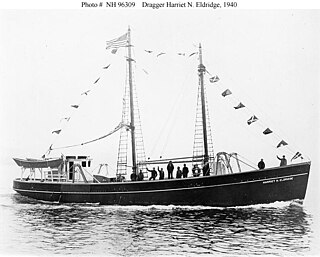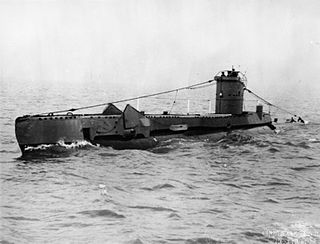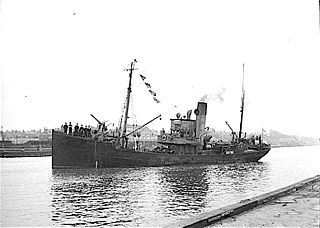USS Captor (PYc-40), briefly the seventh ship to bear the name USS Eagle (AM-132), was a Q-ship of the United States Navy.

A minesweeper is a small naval warship designed to engage in minesweeping. Using various mechanisms intended to counter the threat posed by naval mines, waterways are kept clear for safe shipping.

USS Flamingo (AMc-22) was a coastal minesweeper of the United States Navy.
USS Goshawk (AM-79), was a Goshawk class minesweeper built in 1919 as the steel-hulled fishing trawler M/V Penobscot by the Foundation (Marine) Co., Savannah, Georgia, for Mr. W. F. Henningsen, Seattle, Washington.
The Hawk-class were a minesweeper class of the United States Navy during World War II.

HMS Terrapin was a British submarine of the third group of the T class. She was built as P323 by Vickers Armstrong, Barrow and Belliss and Morcom Ltd, and launched on 31 August 1943. So far she has been the only ship of the Royal Navy to bear the name Terrapin, after the animal of that name. Apart from a brief period in home waters off the Scandinavian coast, Terrapin served in the Far East for much of her wartime career.

HMS Untiring (P59) was a Royal Navy U-class submarine built by Vickers-Armstrong. So far she has been the only ship of the Royal Navy to bear the name Untiring. After the war, she was loaned to the Greek Navy and renamed Xifias (Y-10).

The Royal Naval Patrol Service (RNPS) was a branch of the Royal Navy active during both the First and Second World Wars. The RNPS operated many small auxiliary vessels such as naval trawlers for anti-submarine and minesweeping operations to protect coastal Britain and convoys.

The Castle-class minesweeper was a highly seaworthy naval trawler adapted for patrol, anti-submarine warfare and minesweeping duties and built to Admiralty specifications. Altogether 197 were built in the United Kingdom between 1916 and 1919, with others built in Canada, India and later New Zealand. Many saw service in the Second World War.

A naval trawler is a vessel built along the lines of a fishing trawler but fitted out for naval purposes. Naval trawlers were widely used during the First and Second World Wars. Fishing trawlers were particularly suited for many naval requirements because they were robust boats designed to work heavy trawls in all types of weather and had large clear working decks. One could create a mine sweeper simply by replacing the trawl with a mine sweep. Adding depth charge racks on the deck, ASDIC below, and a 3-inch (76 mm) or 4-inch (102 mm) gun in the bow equipped the trawler for anti-submarine duties.

The R boats were a group of small naval vessels built as minesweepers for the Kriegsmarine before and during the Second World War. They were used for several purposes during the war, and were also used post-war by the German Mine Sweeping Administration for clearing naval mines.

HMAS Goorangai was a 223-ton auxiliary minesweeper of the Royal Australian Navy (RAN). She was built in 1919 for the Government of New South Wales, then sold in 1926 to the fishing company Cam & Sons. The trawler was requisitioned for military service following the outbreak of World War II, converted into a minesweeper, and assigned to Melbourne. She was sunk in an accidental collision with MV Duntroon in 1940, becoming the RAN's first loss of World War II, and the first RAN surface ship to be lost in wartime.
MSA Bermagui (1121) was an auxiliary minesweeper operated by the Royal Australian Navy (RAN). Launched in 1973 as Nadgee II, the vessel was operated commercially as a tuna-fishing boat until March 1994, when she was acquired under the RAN's Craft of Opportunity Program for use as an auxiliary. During military service, she had a crew of eight. The ship left service in 2000. Bermagui was sold at auction for A$190,000 in April 2000, to Mosman Bay Boat Charters.

The No.1 class auxiliary minesweeper was a class of minesweepers of the Imperial Japanese Navy (IJN), serving during World War II. 22 vessels were planned and built in 1941–43 under the Maru Rin Programme and the Maru Kyū Programme.

The Craft of Opportunity Program (COOP) was a Royal Australian Navy (RAN) acquisition program intended to supplement the navy's mine warfare capability with civilian vessels that could be quickly converted into minesweepers. Vessels acquired under COOP were not commissioned into the RAN, and instead operated with the prefix "MSA".
MSA Koraaga (1185) was an auxiliary minesweeper operated by the Royal Australian Navy (RAN). Built by Ante Franov Launched in 1973 as Grozdana A.' for Anton Blaslov', the vessel was operated commercially as a tuna-fishing boat until she was acquired under the RAN's Craft of Opportunity Program in 1990 for use as an auxiliary. During military service, she had a crew of nine.
Two ships of the Royal Australian Navy have been named Brolga, after the brolga.
Two ships have been named Koraaga.

Minesweeper flotillas of the Kriegsmarine were administrative units which grouped German minesweepers together. There were three types of minesweeper flotillas: standard minesweepers, auxiliary minesweepers, and "mine barrage" vessels. Flotilla commanders operated from a shore office, and were usually commanded by an officer ranked as a Korvettenkapitän. All minesweeper flotillas were under the command of the Führer der Minensuchboote which, by 1940, had been divided into three separate offices for activities in the North Sea, Baltic Sea, and off the coast of France.
This page is based on this
Wikipedia article Text is available under the
CC BY-SA 4.0 license; additional terms may apply.
Images, videos and audio are available under their respective licenses.












